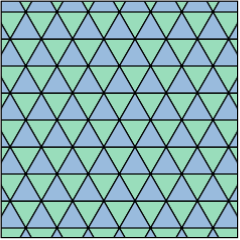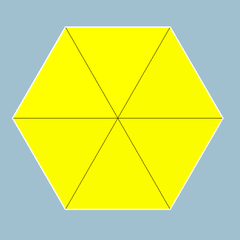- Triangular tiling
-
Triangular tiling 
Type Regular tiling Vertex configuration 3.3.3.3.3.3 (or 36) Schläfli symbol(s) {3,6}
{3[3]}Wythoff symbol(s) 6 | 3 2
3 | 3 3
| 3 3 3Coxeter-Dynkin(s) 















Symmetry p6m, [6,3], *632
p3m1, [3[3]], *333
p3, [3[3]]+, 333Dual Hexagonal tiling Properties Vertex-transitive, edge-transitive, face-transitive 
3.3.3.3.3.3 (or 36)In geometry, the triangular tiling is one of the three regular tilings of the Euclidean plane. Because the internal angle of the equilateral triangle is 60 degrees, six triangles at a point occupy a full 360 degrees. The triangular tiling has Schläfli symbol of {3,6}.
Conway calls it a deltille, named from the triangular shape of the greek letter delta (Δ). The triangular tiling is roughly the kishextile.
It is one of three regular tilings of the plane. The other two are the square tiling and the hexagonal tiling.
This vertex arrangement is called the A2 lattice.[1]
Contents
Uniform colorings
There are 9 distinct uniform colorings of a triangular tiling. (Naming the colors by indices on the 6 triangles around a vertex: 111111, 111112, 111212, 111213, 111222, 112122, 121212, 121213, 121314)
Four of the colorings are generated by Wythoff constructions. Seven of the nine distinct colorings can be made as reductions of the four coloring: 121314. The remaining two, 111222 and 112122, have no Wythoff constructions.
Coloring
indices111111 121212 121314 121213 Coloring 



Symmetry *632
(p6m)
[6,3]*333
(p3m1)
[3[3]]333
(p3)
[3[3]]+3*3
(p31m)
[6,3+]Wythoff symbol 6 | 3 2 3 | 3 3 | 3 3 3 Coxeter-Dynkin 




















Coloring
indices111222 112122 111112 111212 111213 Coloring 




Symmetry 2*22
(cmm)
[∞,2+,∞]2222
(p2)
[∞,2,∞]+*333
(p3m1)
[3[3]]*333
(p3m1)
[3[3]]333
(p3)
[3[3]]+Related polyhedra and tilings
The planar tilings are related to polyhedra. Putting fewer triangles on a vertex leaves a gap and allows it to be folded into a pyramid. These can be expanded to Platonic solids: five, four and three triangles on a vertex define an icosahedron, octahedron, and tetrahedron respectively.
This tiling is topologically related as a part of sequence of regular polyhedra with Schläfli symbols {3,n}, continuing into the hyperbolic plane.

{3,3}
{3,4}
{3,5}
{3,6}
{3,7}
{3,8}
{3,9}It is also topologically related as a part of sequence of Catalan solids with face configuration Vn.6.6, and also continuing into the hyperbolic plane.

V3.6.6
V4.6.6
V5.6.6
V6.6.6
V7.6.6See also
- Tilings of regular polygons
- List of uniform tilings
Notes
References
- Coxeter, H.S.M. Regular Polytopes, (3rd edition, 1973), Dover edition, ISBN 0-486-61480-8 p.296, Table II: Regular honeycombs
- Grünbaum, Branko ; and Shephard, G. C. (1987). Tilings and Patterns. New York: W. H. Freeman. ISBN 0-716-71193-1. (Chapter 2.1: Regular and uniform tilings, p.58-65)
- Williams, Robert (1979). The Geometrical Foundation of Natural Structure: A Source Book of Design. Dover Publications, Inc. ISBN 0-486-23729-X. p35
- John H. Conway, Heidi Burgiel, Chaim Goodman-Strass, The Symmetries of Things 2008, ISBN 978-1-56881-220-5 [1]
External links
- Weisstein, Eric W., "Triangular Grid" from MathWorld.
- Richard Klitzing, 2D Euclidean tilings, x3o6o - trat - O2
Categories:
Wikimedia Foundation. 2010.
